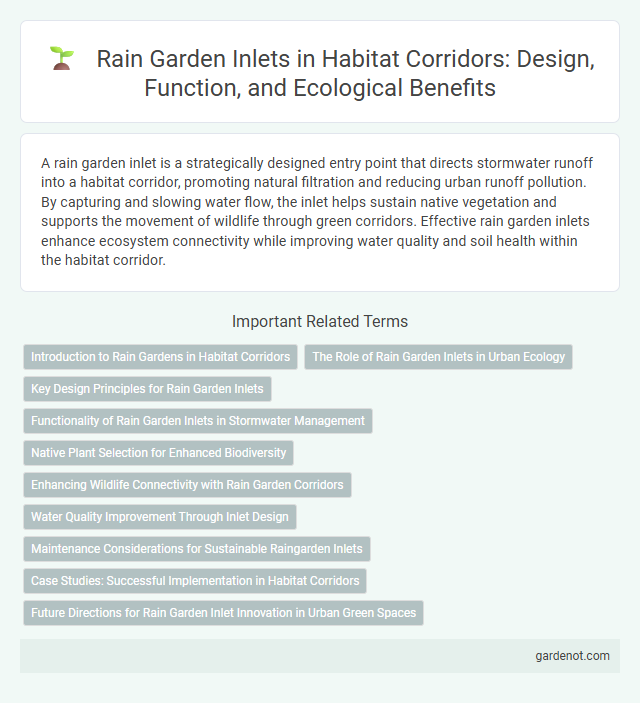A rain garden inlet is a strategically designed entry point that directs stormwater runoff into a habitat corridor, promoting natural filtration and reducing urban runoff pollution. By capturing and slowing water flow, the inlet helps sustain native vegetation and supports the movement of wildlife through green corridors. Effective rain garden inlets enhance ecosystem connectivity while improving water quality and soil health within the habitat corridor.
Introduction to Rain Gardens in Habitat Corridors
Rain garden inlets are essential components in habitat corridors, designed to capture and filter stormwater runoff before it enters natural waterways. These vegetated basins promote groundwater recharge and provide habitat for native plants and wildlife, enhancing biodiversity within urban and suburban landscapes. Properly integrating rain gardens into habitat corridors reduces pollution, mitigates flooding, and supports ecological connectivity.
The Role of Rain Garden Inlets in Urban Ecology
Rain garden inlets play a crucial role in urban ecology by managing stormwater runoff and reducing pollution entering natural habitats. These structures filter contaminants through vegetation and soil, enhancing water quality and supporting biodiversity within habitat corridors. Integrating rain garden inlets in urban planning promotes sustainable ecosystems and mitigates the environmental impact of urban development.
Key Design Principles for Rain Garden Inlets
Rain garden inlets must be designed to effectively channel runoff while minimizing sediment and debris entry to maintain infiltration capacity. Key design principles include sizing the inlet to handle peak stormwater flow, incorporating pretreatment features like sediment traps or forebays, and ensuring gradual water entry to prevent erosion within the rain garden. Selecting durable, permeable materials and integrating native vegetation around the inlet promotes filtration and enhances habitat corridor connectivity.
Functionality of Rain Garden Inlets in Stormwater Management
Rain garden inlets function as critical entry points for stormwater runoff, directing it into planted depressions that naturally filter pollutants and reduce flow velocity. By facilitating infiltration and promoting groundwater recharge, these inlets help mitigate urban flooding and improve water quality. Effective design of rain garden inlets ensures optimal capture of stormwater, enhancing overall habitat corridor resilience and sustainability.
Native Plant Selection for Enhanced Biodiversity
Native plant selection in rain garden inlets significantly boosts habitat corridor biodiversity by providing essential food and shelter for local wildlife species. Choosing indigenous plants adapted to regional soil and climate conditions enhances water filtration and supports pollinators, aiding ecosystem resilience. Incorporating diverse native flora creates microhabitats that connect fragmented landscapes and promote species movement within habitat corridors.
Enhancing Wildlife Connectivity with Rain Garden Corridors
Rain garden inlets serve as critical components in habitat corridors by filtering stormwater and creating microhabitats that support diverse wildlife species. These engineered green spaces facilitate the movement of amphibians, insects, and small mammals, enhancing landscape connectivity and biodiversity. Incorporating rain garden corridors into urban planning addresses habitat fragmentation and promotes ecological resilience in fragmented ecosystems.
Water Quality Improvement Through Inlet Design
Rain garden inlets enhance water quality by effectively capturing and filtering stormwater runoff before it reaches natural habitats. Strategic inlet design utilizes sediment traps and vegetation buffers to reduce pollutants such as sediments, heavy metals, and nutrients. Properly engineered inlets increase infiltration rates, promoting groundwater recharge and minimizing pollutant loads in adjacent aquatic ecosystems.
Maintenance Considerations for Sustainable Raingarden Inlets
Regular inspection and removal of debris from rain garden inlets prevent clogging and maintain optimal water flow, reducing erosion and sediment buildup. Vegetation management, including pruning and replacing damaged plants, supports filtration efficiency and enhances habitat value within the habitat corridor. Periodic assessment of soil conditions and inlet structure ensures long-term sustainability and effective stormwater management.
Case Studies: Successful Implementation in Habitat Corridors
Rain garden inlets have been successfully integrated into habitat corridors to manage stormwater runoff and improve water quality. In Seattle's urban greenbelt corridors, these installations reduced pollutant loads by up to 40%, enhancing aquatic habitats and supporting biodiversity. Case studies from Portland demonstrate that strategically placed rain garden inlets increase native plant resilience and create connectivity for wildlife movement within fragmented landscapes.
Future Directions for Rain Garden Inlet Innovation in Urban Green Spaces
Future directions for rain garden inlet innovation focus on integrating advanced filtration technologies and smart monitoring systems to enhance water quality and manage stormwater efficiently in urban green spaces. Incorporating native vegetation and modular design improves habitat connectivity and biodiversity within habitat corridors. Emphasizing sustainable materials and adaptive designs supports resilience against climate change impacts while promoting ecosystem services.
Rain garden inlet Infographic

 gardenot.com
gardenot.com